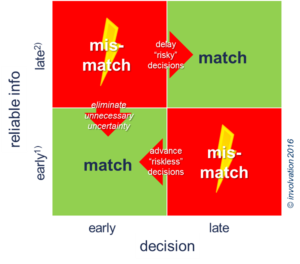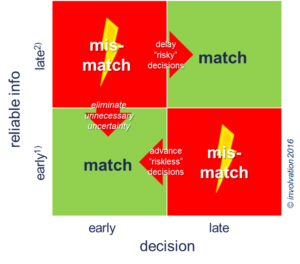This is Demand Driven SCM – Part 3

In Part Two of this four-parter we zoomed in on the importance of the ‘moment of decision’. Preferably, we should make a decision early if the information is reliable at an early stage, and late if it doesn’t become reliable until later. This is not always the case in practice, however, which creates a ‘planning mismatch’. This planning mismatch is a recipe for disappointment and disaster, albeit unknowingly and unwittingly, and the source of misalignment. So if we want to break the service paradox, then we will have to escape the planning mismatch. But the question is, how?
Three DDSCM strategies
 As it turns out, the answer is surprisingly simple. After all, the decision matrix reveals three complementary strategies for escaping the planning mismatch:
As it turns out, the answer is surprisingly simple. After all, the decision matrix reveals three complementary strategies for escaping the planning mismatch:
- Delay risky decisions until sufficient reliable information is available;
- Make use of information that is available at an early stage in order to advance forward riskless decisions;
- And avoid unnecessary variation and uncertainty.
Incidentally, these three strategies not only complement one another but are also interlinked. After all, delaying risky decisions calls for short response times. This requires certainty and stability, which can both be gained by bringing forward riskless decisions. But to do so, it is important to eliminate unnecessary uncertainty, which in turn means eliminating unnecessary variation. After all, variation is what causes uncertainty. If these three strategies are applied correctly they actually reinforce one another.
This train of thought reveals that by eliminating unnecessary variation and uncertainty and by bringing forward riskless decisions, we can delay risky decisions in order to successfully escape the planning mismatch and reduce our dependence on chronically unreliable forecasts and plans. This safeguards alignment and gives the end customer what they want, when they want it and without waste: a win/win situation which breaks the service paradox with ease – or in other words, a demand-driven supply chain (DDSC).
Definition of DDSCM
By describing the essence of a DDSC, we have also unearthed the core of what Demand Driven Supply Chain Management (DDSCM) is and why you should want it.
Demand Driven SCM – a collection of supply-chain initiatives that enable companies to escape the planning mismatch and to lessen their reliance on forecasting by improving agility and response times, thanks to eliminating unnecessary variation and uncertainty and advancing riskless decisions.
Opting for DDSCM implies that you no longer accept your dependence on chronically unreliable forecasts and plans caused by long response times and unnecessary variation and uncertainty. Otherwise, it is impossible to achieve DDSCM.
The ‘demand-driven’ aspect stems from the fact that, in the extreme case, risky decisions are delayed until the actual demand level is known and that forecasts are based on the need at source, i.e. before the need can be distorted by ‘self-inflicted’ variation.
So now we know what DDSCM is and why you should want it, the only question remaining is how DDSCM can help you in practice. In the fourth and final part of this four-parter, we help you to answer this question by introducing DDSCM’s Wheel of 5
This brings us to the end of Part Three of our four-parter on Demand Driven Supply Chain Management. If you would like to know more, feel free to contact Alex Tjalsma: a.tjalsma@involvation.com


